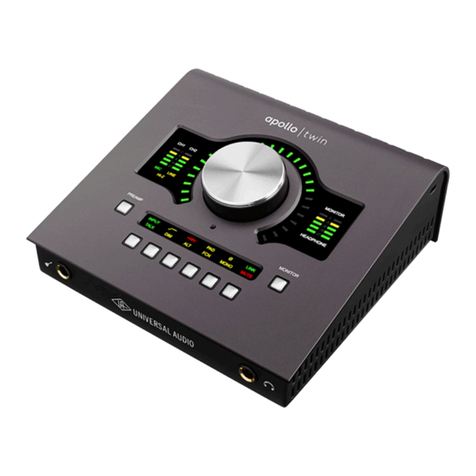
CX ENCODER/DECODER MODEL
1181
The UREI Model 1181 CX Encoder/Decoder offers the
mastering, production or mixdown facility the ability to
precisely record and playback according to the CBS
Technology CX disc noise reduction standard.
The CX noise reduction system is designed for phonograph
and video disc recording and reproduction. In the encoding
process which is done during disc mastering, all signals below
apreset threshold level are not compressed —in the CX
20 position, the threshold is -40 dB ref. 0VU*, and in the
CX 15 position, the threshold is -30 dB. Above this threshold,
all program is compressed with 2:1 ratio, using asignal-
dependent variable time constant. In decoding, complementary
expansion takes place, using the same signal-dependent
variable time constant.
The 1181 includes encoders for Preview and Program channels
and adecoder which may be switched to audition preview,
program or any “line level” external source. The encoders
are highly accurate 2:1 compressors switchable for CX 15 or
CX 20 conformance. High technology gain control blocks,
audio operational amplifiers and precision control circuits
assure excellent performance and long term stability. The
decoder or expander section is amirror of the encoder, using
the identical gain control circuitry to assure accurate play-
back tracking. Operating modes can also be remotely controlled
through arear panel connector so that the 1181 may be
installed wherever convenient.
*For phonograph records, 0VU corresponds to 3.54 cm/sec
groove modulation at 1kHz.
FEATURES:
•Preview, Program and Audition in two rack spaces
(3V2").
•Tamper resistant, screwdriver adjust setup controls
behind security cover.
•Fully automatic operation after initial setup. No special
techniques need be learned by the mastering engineer.
•Relay bypass with power off.
•LEDs allow setup with 0.1 dB resolution.
•Extremely low noise and distortion.
•Remote mode selection.
•Full metering matrix.
•Built and backed by UREI.
UNITED RECORDING ELECTRONICS INDUSTRIES
8460 SAN FERNANDO RD., SUN VALLEY, CALIFORNIA 91352
TELEX 65-1389 UREI SNVY (213) 767-1000 MODEL
1181




























